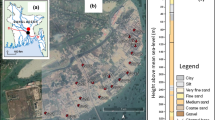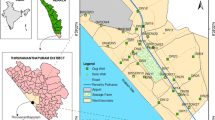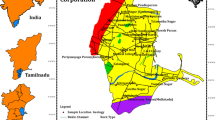Abstract
Heavy metal pollution index (HPI), is a rating method and an effective tool to assess the water quality with respect to heavy metals. Twenty-seven groundwater samples were collected from the municipal drinking water supply in Damascus Oasis. The metals such as cadmium (Cd), lead (Pb), copper (Cu) and zinc (Zn) were considered. The metal concentrations showed a dominance in the order of Zn > Cu > Pb > Cd, respectively. The value of HPI based on the mean concentration was found to be 8.58, which is far below the critical pollution index value of 100. Most of the groundwater samples (74 %) have an HPI lower than the mean value of 8.58. Whereas, 26 % of the samples exceed this mean and only one sample reaches the limit of low pollution by heavy metal. Spatial distribution of HPI is in well agreement with the metals’ spatial distribution and showed the high values of HPI in the south eastern part of Damascus city to the center and especially in the northeastern part of the study area. This indicates the effect of industrial zone, agriculture and urban activity. It indicated that the groundwater at the northeast of the studied area is likely affected by leaching of heavy metal from the sewage water treatment station.






Similar content being viewed by others
References
Abdullah EJ (2013) Evaluation of surface water quality indices for heavy metals of Diyala River-Iraq. J Nat Sci Res 3(8):63–69
Abou Zakhem B, Hafez R (2001) General hydro-isotopic study of direct infiltration and evaporation process through the unsaturated zone in Damascus Oasis, Syria, IAEA-Tec.Doc.-273, Vienna, pp 131–170
Adaikpoh EO, Nwajei GE, Ogala JE (2005) Heavy metals concentrations in coal and sediments from River Ekulu in Enugu, coal city of Nigeria. J Appl Sci Environ Manag 9(3):5–8
Adams RH, Guzmán Osorio FJ, Zavala Cruz J (2008) Water repellency in oil contaminated sandy and clayey soils. Int J Environ Sci Tech 5(4):445–454
Aktar MW, Paramasivam M, Ganguly M, Purkait S, Sengupta D (2010) Assessment and occurrence of various heavy metals in surface water of Ganga River around Kolkata: a study for toxicity and ecological impact. Environ Monit Assess 160(1–4):207–213
Alvarez AM, Alvarez JRE, Alvarez RP (2007) Heavy metal analysis of rain waters: a comparison of TXRF and ASV analytical capabilities. J Radioanal Nucl Chem 273(2):427–433
Ammann AA, Michalke B, Schramel P (2002) Speciation of heavy metals in environmental water by ion chromatography coupled to ICP-MS. Anal Bioanal Chem 372(3):448–452
Bardos P (2004) Composting of mechanically segregated fractions of municipal solid waste, a review. Sita Environmental Trust, Falfield
Charles TD, James KO, Akeiverfeldt (1994) Biogeochemistry of small catchments: a tool for environmental research. In: Moldan B, Cemy J (eds) Trace metals speciation and cycling, 13th edn. Wiley, UK
Gowd SS, Govil PK (2008) Distribution of heavy metals in surface water of Ranipet industrial area in Tamil Nadu, India. Environ Monit Assess 136:197–207
Hatje V, Bidone ED, Maddock JL (1998) Estimation of the natural and anthropogenic components of heavy metal fluxes in fresh water Sinos river, Rio Grande do Sul state, South Brazil. Environ Tech 19(5):483–487
Homsi M, Bouni M, Kurdi A (1989) Damascus basin climate and its role in economical plans and the climatic changes. National meteorology report 35 (unpublished report)
Karbassi AR, Amirnezhad R (2004) Geochemistry of heavy metals and sedimentation rate in a bay adjacent to the Caspian Sea. Int J Environ Sci Tech 1(3):191–198
Karbassi AR, Monavari SM, Nabi Bidhendi GR, Nouri J, Nematpour K (2008) Metal pollution assessment of sediment and water in the Shur River. Environ Monit Assess 147(13):107–116
Kar D, Sur P, Mandal SK, Saha T, Kole RK (2008) Assessment of heavy metal pollution in surface water. Int J Environ Sci Tech 5(1):119–124
Khandekar RN, Tripathi RM, Rahnnath R, Mishra VC (1988) Simultaneous determination of Pb, Cd, Zn, Cu in surface soil using differential pulse anodic stripping voltametry. Indian J Environ Health 30:98–103
Kumar PJS, Delson PD, Babu PT (2012) Appraisal of heavy metals in groundwater in Chennai city using a HPI model. Bull Environ Contam Toxicol 89:793–798. doi:10.1007/s00128-012-0794-5
Lee CL, Li XD, Zhang G, Li J, Ding AJ, Wang T (2007) Heavy metals and Pb isotopic composition of aerosols in urban and suburban areas of Hong Kong and Guangzhou, South China evidence of the long-range transport of air contaminants. Environ Pollut 41(2):432–447
Lohani MB, Singh S, Rupainwar DC, Dhar DN (2008) Seasonal variations of heavy metal contamination in river Gomti of Lucknow city region. Environ Monit Assess 147(1–3):253–263
Manoj K, Kumar Padhy P, Chaudhury S (2012) Study of heavy metal contamination of the river water through index analysis approach and environmetrics. Bull Environ Pharmacol Life Sci 1(10):7–15
Marcovecchio JE, Botte SE, Freije RH (2007) Heavy metals, major metals, trace elements. Handbook of water analysis. CRC Press, London
Melhem R, Higano Y (2010) Policy measures for river water management in Barada Basin, Syria. Ministry of Environment, Damascus
Ministry of Environment (1994) Drinking water quality standards. Higher council for Environment and safety, Damascus (Arabic)
Ministry of Environment (1996) Syrian standard for wastewater discharged to sewerage system. Ministry of Environment Document, Damascus (Arabic)
Ministry of Housing (2000) Adra treatment plant. The Ministry of Housing documents, Damascus
Ministry of Environment (2001) National overview of chemicals pollution and safety. Ministry of Environment Document, Damascus (Arabic)
Mohan SV, Nithila P, Reddy SJ (1996) Estimation of heavy metal in drinking water and development of heavy metal pollution index. J Environ Sci Health A 31(2):283–289
Momodu MA, Anyakora CA (2010) Heavy metal contamination of ground water: the Surulere case study. Res J Environ Earth Sci 2:39–43
Nouri J, Mahvi AH, Jahed GR, Babaei AA (2008) Regional distribution pattern of groundwater heavy metals resulting from agricultural activities. Environ Geo 55(6):1337–1343
Ponikarov VP (1966) Explanatory notes on the geological map of Syria, scale 1/200.000, sheet VII (Damascus) Techno-export
Prasad B, Kumari S (2008) Heavy metal pollution index of ground water of an abandoned open cast mine filled with fly ash: a case study. Mine Water Environ 27(4):265–267
Prasad B, Mondal KK (2008) The impact of filling an abandoned opencast mine with fly ash on ground water quality: a case study. Mine Water Environ 27(1):40–45
Reiners WA, Marks RH, Vitousek PM (1975) Heavy metals in subalpine soils of New Hampshire. Oikos 26:264
Reza R, Singh G (2010) Assessment of heavy metal contamination and its indexing approach for river water. Int J Environ Sci Tech 7(4):785–792
Reza R, Singh G, Jain Manish K (2011) Application of heavy metal pollution index for ground water quality assessment in Angul district of Orissa, India. Int J Res Chem Environ 1(2):118–122
Selkhozpromexport (1986) Water resources use in Barada and Awage basins for irrigation of crops, vol II, book 2, USSR, Moscow, pp 484
Shawaf S (2000) The contamination of Barada River. Ministry of Irrigation documents, Damascus (Arabic)
Sheykhi V, Moore F (2012) Geochemical characterization of Kor River water quality, Fars Province, Southwest Iran. Water Qual Expo Health 4:25–38
Sonthalia P, McGaw E, Show Y, Greg M, Swain GM (2004) Metal ion analysis in contaminated water samples using anodic stripping voltammetry and a nanocrystalline diamond thin-film electrode. Anal Chimica Acta 522:35–44
Soumi G, Chayeb R (1989) Water need and plant irrigation techniques. UNDP, FAO, SYR/86/015, Technical report, Agriculture Ministry, pp 33
Suthar S, Singh S (2008) Vermicomposting of domestic waste by using two epigeic earthworms (Perionyx excavatus and Perionyx sansibaricus). Int J Environ Sci Tech 5(1):99–106
Vinodhini R, Narayanan M (2008) Bioaccumulation of heavy metals in organs of fresh water fish Cyprinus carpio (Common carp). Int J Environ Sci Tech 5(2):179–182
WHO (1993). Guidelines for drinking water quality. World Health Organization, Geneva. 2nd edn. vol 1: Recommendations, p 188
WHO (2008) Guidelines for drinking water quality, vol 1, 3rd edn. World Health Organization, Geneva, p 515
WHO (2011) Guidelines for drinking water quality, 4th edn. World Health Organization, Geneva, p 340
World Bank Group (1998) Pollution prevention and abatement handbook, World Bank
Yankey RK, Fiank JR, Osae S, Ahialey EK, Duncan AE, Essuman DK, Bentum JK (2013) Evaluation of heavy metal pollution index of groundwater in the Tarkwa mining area, Ghana. Elixir Pollut 54:2663–12667
Acknowledgments
The authors would like to gratefully acknowledge Prof. Dr. I. Othman, director general of Atomic Energy Commission of Syria (AECS), for his guidance and support. Special thanks to Dr. K. M. Kulkarni technical officer of the CRP n° SYR.11517 (IAEA). Thanks to S. A. Baker, S. Ibrahim, H. Issa and O. Shayiah in the AECS laboratory for heavy metal analysis. Thanks to B. Katta for mapping work and M. Yaya for the field work achievement. Finally, thanks to the laboratory team and colleagues in Geology Department (AECS). This study was done under the framework of CRP project no. SYR.11517 in cooperation with International Atomic Energy Agency (IAEA) entitled “Application of isotopes to the assessment of pollutant behavior in the unsaturated zone for groundwater protection”.
Author information
Authors and Affiliations
Corresponding author
Rights and permissions
About this article
Cite this article
Abou Zakhem, B., Hafez, R. Heavy metal pollution index for groundwater quality assessment in Damascus Oasis, Syria. Environ Earth Sci 73, 6591–6600 (2015). https://doi.org/10.1007/s12665-014-3882-5
Received:
Accepted:
Published:
Issue Date:
DOI: https://doi.org/10.1007/s12665-014-3882-5




